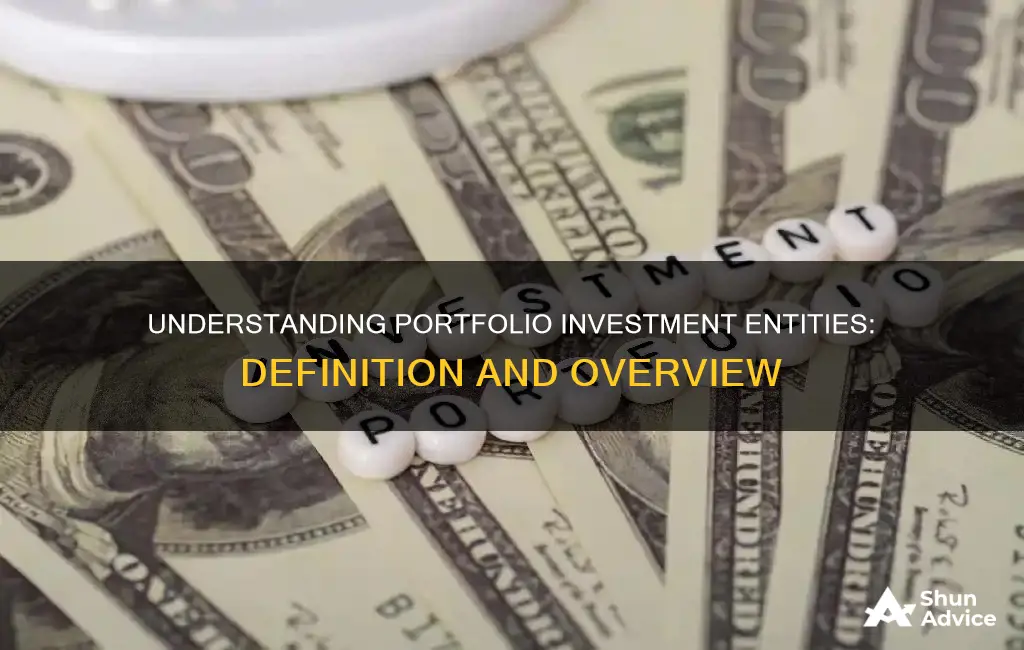
A portfolio investment entity, commonly abbreviated as PIE, is a type of investment entity that offers tax benefits to individual investors. PIEs pool investors' money and place them in diverse assets, spreading risk and potential reward. This financial mechanism or institution oversees a broad range of assets for its stakeholders, collecting resources from several investors and channelling them into diverse investment tools such as equities, fixed-income securities, mutual funds, ETFs, and other market instruments. The primary objective of a PIE is to strike a balance between potential risks and rewards by distributing investments among various sectors and asset categories.
| Characteristics | Values |
|---|---|
| Full Form | Portfolio Investment Entity |
| Abbreviation | PIE |
| Type of Entity | Investment Entity |
| Type of Investment | Passive Investment |
| Tax Benefits | Yes |
| Tax Rules | Special |
| Tax Rate | Prescribed Investor Rate (PIR) |
| Investor Type | Individual Investors |
| Investment Type | Diverse Assets |
| Investment Objective | Harmony between Potential Risks and Rewards |
| Management | Expert/Professional |
| Investor Participation | Yes |
| Liquidity | Yes |
| Regulatory Oversight | Yes |
What You'll Learn

PIEs are a type of investment entity with tax advantages
A Portfolio Investment Entity (PIE) is a type of investment entity that offers tax advantages. PIEs are financial institutions that pool investors' money and invest it in a diverse range of assets, from equities to mutual funds. This diversification is a risk-management strategy, ensuring that underperformance in one area does not negatively impact the entire portfolio.
PIEs are subject to special tax rules, which can benefit investors. When investing in a PIE, individuals pay tax on any investment income based on their Prescribed Investor Rate (PIR) rather than their personal income tax rate. This can result in considerable tax savings, as the PIR is often lower than an individual's regular tax rate. For example, in New Zealand, the highest PIR is 28%, whereas the highest income tax rate is 39%.
The PIE will pay tax based on each investor's PIR, and this is usually a 'final' tax, meaning the investor does not need to include this income in their tax return. PIEs that invest in New Zealand and certain Australian shares are also exempt from tax on capital gains or losses.
The tax advantages of PIEs are particularly beneficial for those who pay income tax at a higher rate, have recently returned to the workforce after a long break, or have experienced a significant increase in salary, resulting in a higher income tax rate.
Saving and Investment Economics: Core Concepts Explained
You may want to see also

PIEs pool investors' money into diverse assets
A Portfolio Investment Entity (PIE) is a type of investment entity that offers tax benefits to individual investors. PIEs pool investors' money and place it in diverse assets, spreading risk and potential rewards. This financial mechanism or institution manages a wide range of assets for its stakeholders.
PIEs collect resources from several investors and channel them into various investment tools, such as equities, fixed-income securities, mutual funds, ETFs, and other market instruments. The primary objective of a PIE is to balance potential risks and rewards by distributing investments across sectors and asset categories. This approach helps reduce collective risk by ensuring investment variety and risk distribution.
By pooling funds from numerous investors and spreading them across a range of assets, PIEs can mitigate the potential negative impact of a single underperforming asset on the overall portfolio. This inherent diversification is a foundational principle of investment. For example, if one investment underperforms, its negative impact on the overall portfolio is cushioned by the performance of other assets.
In addition to diversification, PIEs offer other advantages such as professional management, investor participation, liquidity, and regulatory oversight. Investors can benefit from the expertise of seasoned professionals, who have in-depth market knowledge and analytical tools. PIEs also allow for varying degrees of investor participation, such as choosing fund strategies, setting risk tolerance levels, or voting on fund matters.
Many PIEs offer good liquidity, allowing investors to easily convert their investments into cash by selling their shares or redeeming them with the fund. This feature is particularly valuable for those who need quick access to their funds. Furthermore, PIEs are typically subject to regulatory oversight, ensuring transparency and alignment with investors' best interests.
Maximizing Small Savings: Smart Strategies for Investing Wisely
You may want to see also

PIEs are similar to mutual funds, ETFs, and SICAVs
A portfolio investment entity (PIE) is a type of investment entity that offers tax advantages to investors. PIEs are similar to mutual funds, ETFs, and SICAVs in several ways. Firstly, like mutual funds and ETFs, PIEs are a form of collective investment scheme, pooling contributions from multiple investors to invest in various assets. This built-in diversification can reduce risk and potential losses for investors.
Secondly, PIEs, mutual funds, ETFs, and SICAVs are all professionally managed. Portfolio managers oversee the investments, selecting and monitoring the assets the funds invest in, saving investors time and effort. While most ETFs and many mutual funds are index funds, portfolio managers ensure the funds adhere to their target indexes.
Thirdly, PIEs, mutual funds, ETFs, and SICAVs provide investors with access to a diverse range of assets, including equities, fixed income, and alternative investments such as real estate, commodities, and hedge funds. This broadens the investment opportunities for investors, allowing them to access assets they may not be able to access individually.
Lastly, PIEs, like mutual funds and ETFs, offer different types or categories, each with distinct abilities and tax requirements. For example, a multi-rate PIE (MRP) allows investors to notify the fund of their prescribed investor rate (PIR), which is used to calculate and deduct their PIE tax. This feature provides tax advantages, as investors pay tax on investment income based on their PIR instead of their personal income tax rate.
Spending, Saving, and Investing: What's the Difference?
You may want to see also

PIEs are not pensions or retirement funds
A Portfolio Investment Entity (PIE) is a type of investment entity that offers tax benefits to individual investors. PIEs are not pensions or retirement funds. While they are sometimes treated as a type of supplemental pension or retirement fund, they are not the same. This distinction is important, especially when considering the tax implications for investors.
PIEs are financial mechanisms or institutions that oversee a broad range of assets for their stakeholders. They collect resources from multiple investors and invest them in diverse assets, spreading risk and potential rewards. The primary objective of a PIE is to balance potential risks and rewards by distributing investments across sectors and asset categories. This approach helps to reduce collective risk by ensuring investment variety and risk distribution.
The tax advantages of PIEs are a key benefit. In some jurisdictions, the tax rate applied to a PIE is lower than an individual's regular tax rate, resulting in tangible tax savings and enhanced overall investment returns. For example, in New Zealand, the highest prescribed investor rate (PIR) is 28%, which is lower than the top income tax rate. This means that investors who pay income tax at a higher rate may benefit from investing in a PIE.
It is important to note that PIEs are not the same as pensions or retirement funds. This distinction has implications for investors, especially regarding tax treatment and reporting requirements. While PIEs may be treated similarly to supplemental retirement plans in some cases, they are not considered pensions or retirement funds per se. As a result, there may be limitations on how investors can use PIEs for tax purposes, especially in international contexts.
Understanding the differences between PIEs and pensions or retirement funds is crucial for investors to make informed decisions and ensure compliance with tax regulations.
Savings Strategies: Maximizing Output from Your Investments
You may want to see also

PIEs are regulated and offer transparency
A portfolio investment entity (PIE) is a type of investment entity that offers tax benefits to individual investors. PIEs are regulated and offer transparency, providing an added layer of protection and confidence for investors.
PIEs are subject to regulatory oversight in their respective jurisdictions. This ensures that they operate with transparency and always act in the best interests of their investors. Regulatory bodies play a crucial role in setting standards for disclosure, reporting, and fair practices. These standards safeguard investors' rights and ensure that PIEs maintain transparency in their operations.
The regulation of PIEs is essential for maintaining investor trust and confidence. It helps protect investors from potential fraud or misconduct and ensures that PIEs adhere to disclosure and reporting requirements. This regulatory framework provides investors with valuable insights into the PIE's operations, enabling them to make informed decisions.
Moreover, the transparency offered by PIEs allows investors to understand the underlying assets and strategies employed by the entity. PIEs are known for their inherent diversification, providing investors with exposure to a wide range of assets and sectors. This diversification strategy reduces the overall risk of the investment portfolio.
In addition to regulatory oversight, PIEs are also subject to specific tax regulations. The taxation of PIE income is based on the Prescribed Investor Rate (PIR), which is often lower than an individual's regular tax rate. This preferential tax treatment can result in significant tax savings for investors.
The PIR takes into account various factors, such as whether the investor is an individual or entity, their residency status, and their prior year(s) tax rate. By paying taxes based on the PIR, investors can benefit from reduced tax liabilities compared to traditional investment vehicles.
Overall, the regulation and transparency offered by PIEs are crucial for maintaining investor confidence and protecting their interests. These factors contribute to the appeal of PIEs as a compelling investment choice for both novice and seasoned investors.
Invest to Grow: Why Smart Investors Shun Savings Accounts
You may want to see also
Frequently asked questions
A portfolio investment entity, commonly abbreviated as PIE, is a type of investment entity that offers tax benefits for individual investors. It is a financial mechanism or institution that oversees a broad range of assets for its stakeholders.
PIEs offer diversification, professional management, and access to broader markets. They also provide liquidity, transparency, and the potential for higher returns.
PIEs can benefit both novice and seasoned investors. They are suitable for those who are new to investing, busy professionals, high-net-worth individuals, retirement savers, risk-averse investors, and institutional investors, among others.







